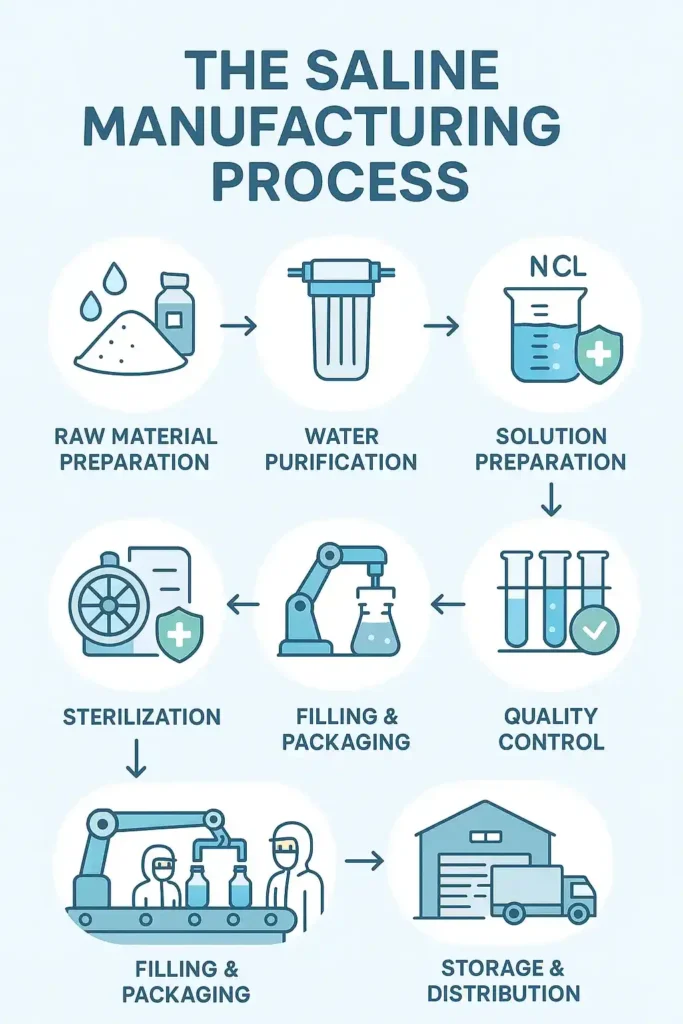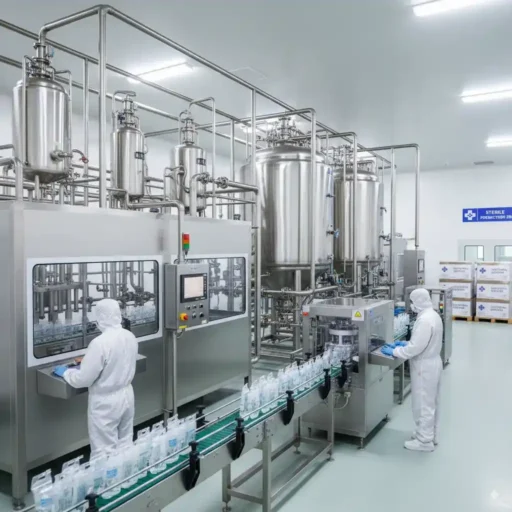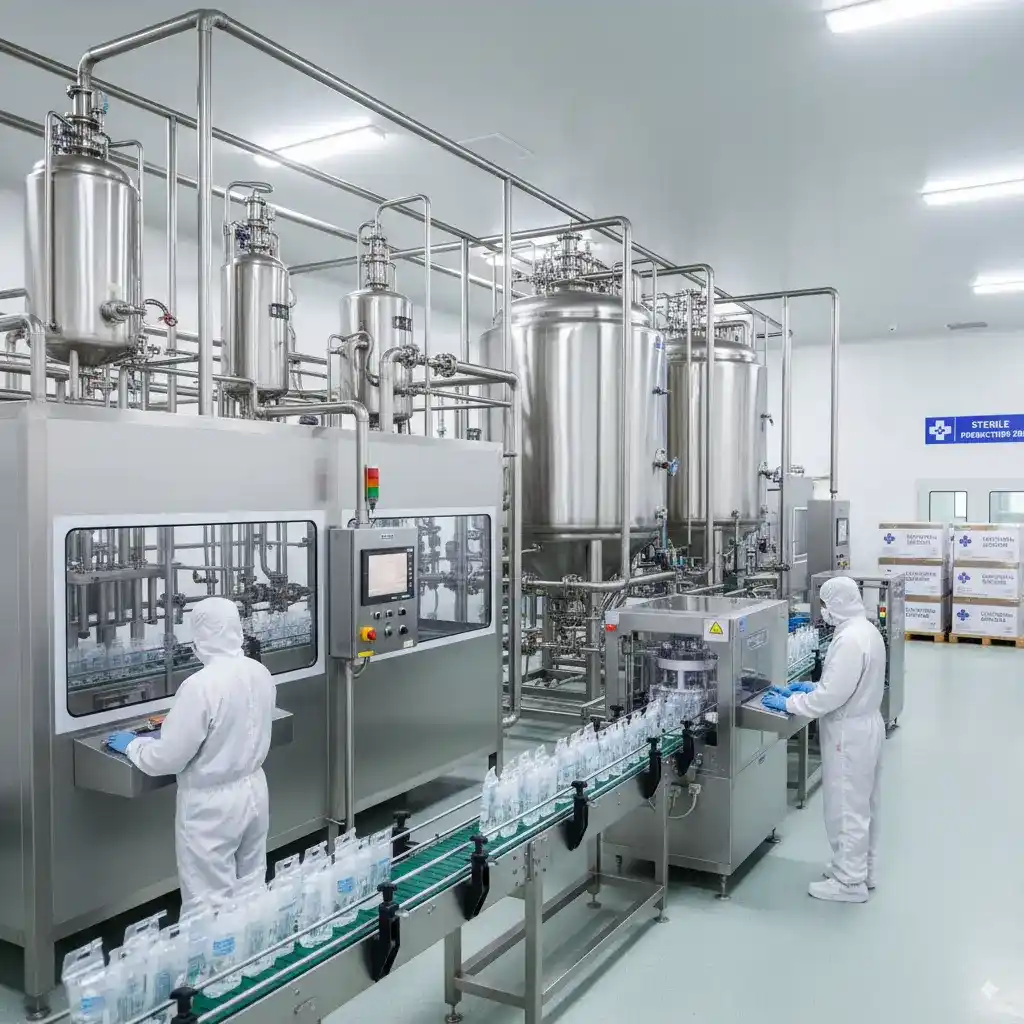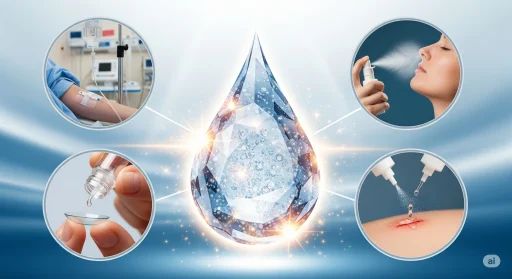A salt solution is a life -saving medical commodity around the world, but few people understand how complex and vital can be its production process.
The fact that in each back of the physical solution is a sophisticated process of solution that draws on strict global patterns, sophisticated technologies and robust supply chains.
In 2025 it was never more critical to produce a salt solution. And the use of sterile salt solutions has countless applications, from helping to protect millions of operations every year to service as an emergency front line.
This NPCS blog will tell you everything you need to know about it: the opinion of the global market, opportunities and challenges and what has the future.
Read Our Book: Click Here
What is the production of salt solution
The production of physiological solution is the preparation of sterile salt water solutions, usually at a concentration of 0.9% in purified water.
This isotonic solution is used for:
- Intravenous hydration (IV)
- Dilution
- Wound irrigation
- Medical procedures such as dialysis
Although it may seem so simple, the physiological solution of the medical class must be held at a high level of safety and quality. The smallest error of contamination or concentration can literally kill the patient, so salt is not on easy street in terms of regulations.
Read More: Biodegradable Products Business: Profitable Eco-Friendly Opportunities in 2025
Standards of regulatory and quality
Salt solution production is not just mixing salt and water. Each lot should be in line with good practices of international production (GMP) and undergo strict tests.
- Water quality: It must be water for injection (WFI) or equivalent. Sterility: Solutions are sterilized by autoclave or sterile filtration.
- Tests: The solution is tested for pH, presence of particles, pyrogens and endotoxins.
- Packaging: sculpture or glass at the level of medical level should be verified to prevent leaching.
- Regulatory supervision comes from: FDA (USA), EMA (Europe), CDSCO (India), which instructions for export.n comes from: FDA (USA), EMA (Europe), CDSCO (India), WHO guidelines for export.
Challenges in the production of physiological solution
Although it is a vital product, salt solutions manufacturers have the main challenges:
- Supplier chain vulnerability: If the package reduces low, you have a global shortage or raw salt or if the installation turns off.
- Slim Margins: Saline is a product with a low amount, so profits are based on efficiency.
- Regulatory barriers: A lot of inspections and certifications add costs.
- Contamination Risks: Minor Sterility breaks can lead to download.
In fact, F.D.A. He recently said that the lack of salt solution finally ended in mid -2025, after years of the offer was limited by hurricanes that damaged the United States’ main races with repair.
Read Our Project Report: Click Here
Industry analysis SWOT
- Strengths: The production of physiological solution benefits from constant demand in healthcare and a simple and highly scalable formula, which makes it a reliable product on global markets.
- Weaknesses: The sector faces high costs of compliance with the regulations as a result of strict regulations and usually works with fine profit margins.
- Opportunities: There is a strong growth potential in Asia and Pacific, along with innovations in balanced salt packages and solutions.
- Threats: The main risks include the lack of catastrophs, as well as intense pressures and prices of the competition.
The process of making saline solution

Preparation of raw materials: This includes the use of pharmaceutical quality of salt and distilled water. The content of sterile bags, bottles and syringes are checked before use.
Water cleaning: The water is cleaned with reverse osmosis, distillation or UV. Everything that does not undergo testing continues to the processes.
Solution preparation: 100 g of sodium chloride was considered precisely and dissolved in purified water homogenized with mixing. Automated systems ensure accuracy.
Sterilization: Sterilization is carried out by autoclave or sterile filtration. Repeated testing shows the destruction of dangerous microorganisms.
Filling and packaging: robotic machines fill and seal containers in clean rooms. All workers will not have everything sterile.
Quality control: Each batch is subject to sterility, pH and concentration testing. Only batch is released for distribution.
Storage and Distribution: Products are kept in a temperature controlled environment. Shipments are monitored and any damaged deliveries are rejected.
Read More: Complete Guide to Building and Scaling a Manufacturing Business
How to start a solution with a solution
Market survey: Check what hospitals want, which rule the market and which license hoops through you.
Narrow regulations: You can’t ignore paperwork. Ask for permission FDA, GMP or CDSCO based on your area.
Settings: Invest cash in legal goods- industrial water cleaners, sterile filling machines and bulletproof packaging lines. The key to sterility, so it is cheaper.
A-TEAM design: You want a legitimate microbiologist, Sharp engineer and a passionate quality control team. It is not a kitchen science, so qualified experts are your tickets for constant quality.
Secure reliable supplier chains: Close reliable sources for raw salt and fast packaging. Smooth deliveries mean that you prevent production at any time. Create specific relationships with distributors to avoid the surprise of the supplier chain.
Selection of the sales channel: Focus on your efforts in hospitals, clinics and big times. Do not ignore government offers – if you play your card correctly, they can turn into fat recurrence contracts.
Read More: Pharmaceutical Manufacturing Trends for 2025: Shaping the Future
Future prospects
The salt water industry in 2025 is located for stable, long -term growth. Global demand will continue to increase, especially in developing economies. With several governments that emphasize domestic production capacity, new players will enter the market.
Expect to see:
- Extensive acceptance of balanced crystalloids
- Innovation of packaging focused on sustainability
- Digitization of production devices for better trackability
- Stronger safety and environmental tracks
Conclusion
Salt solution may seem simple -only salt and water -but its production plays a decisive role in global health care. While we look at 2025 and beyond, the physiological solution will continue to expand, supported by innovation, growing demand and governments that promote resistant health chains of health suppliers.
For investors, entrepreneurs and healthcare workers, it is not only about business to understand the production of salt solutions – it is a contribution to one of the most important pillars of modern medicine. If you want to get further assistance in starting business in this industry, contact us.
Production of physiological solution: often asked questions
Q1. Why is the saline solution always 0.9% of sodium chloride?
Because it is isotonic with the plasma of human blood, which means it does not cause harmful changes in fluid inside or outer cell.
Q2. What caused a recent lack of salt solution?
Natural disasters disrupting factories, lack of stories -unmarked prices and peaks of demand.
Q3. Is it profitable to start a salt factory?
Yes, but only on a scale. The product has low margins, so profitability depends on efficiency, automation and long -term contracts.
Q4. What regulations control the production of salt solutions?
Good production procedures (GMP), FDA (USA), EMA (Europe), CDSCO (India) and WHO instructions for global exports.
Q5. What are the latest trends in the production of physiological solution?
Balanced salt solutions, local production initiatives, ecological packaging and automated quality control systems.







